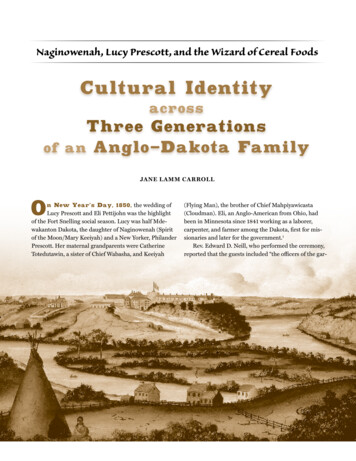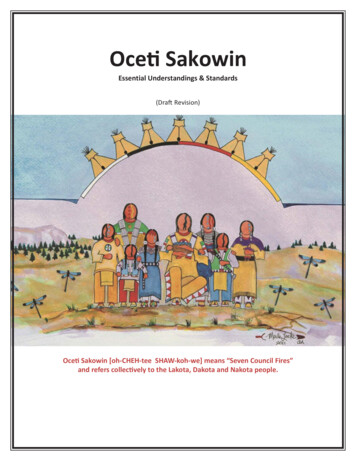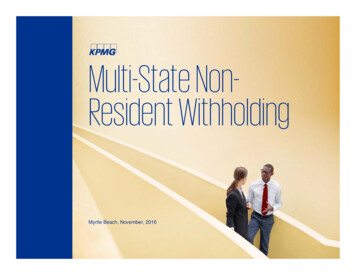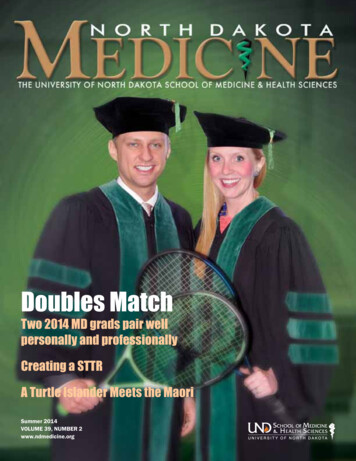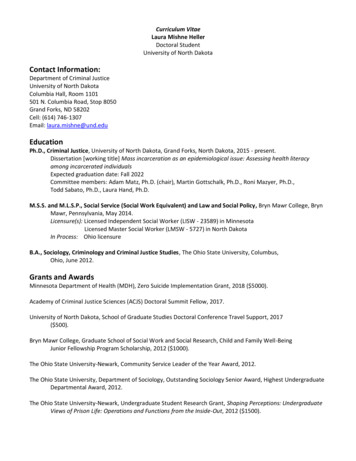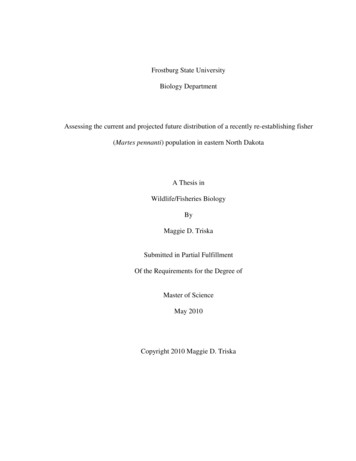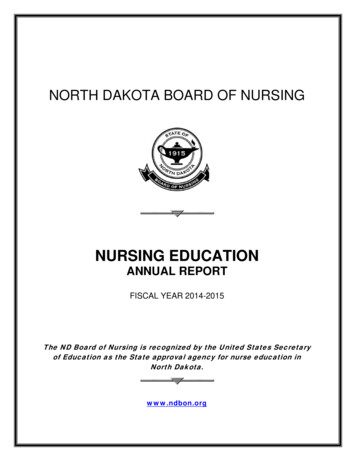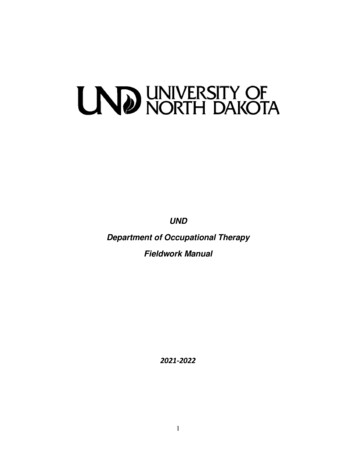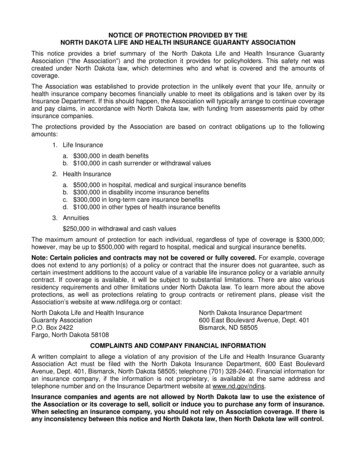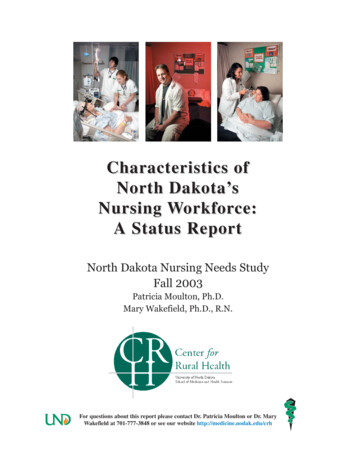
Transcription
Characteristics ofNorth Dak ota’sNursing Workfor ce:A Status ReportNorth Dakota Nursing Needs StudyFall 2003Patricia Moulton, Ph.D.Mary Wakefield, Ph.D., R.N.For questions about this report please contact Dr. Patricia Moulton or Dr. MaryWakefield at 701-777-3848 or see our website http://medicine.nodak.edu/crh
About Nursing .Nursing as a profession needs to be able to attract thebest and the brightest . . . to be able to compete withthe other careers in healthcare that are currently attractingstudents who are proficient in sciences and mathematics.North Dakota RNGrow your own—rural areas need to recruitpromising candidates with roots in thecommunity and provide the means to getthe education needed.North Dakota Nursing FacultyWe as RNs need to promote our profession.We are taught critical thinking.let’s use it!Urban North Dakota RNWe need to work on the image of nurses.not just bedpans and shots.and not just female.North Dakota LPN studentYou hear all the time about teachers’ salaries in ND,but you never hear anything about nurses’ salaries.Maybe it’s our fault. We’re not being proactive.You work hard to save a life, for really, not a verygood salary. That’s unfortunate.Rural North Dakota RNNursing is a very difficult job. There needs tobe good pay for hard work.North Dakota Director of NursingSatisfaction comes from knowing you helped someone.just seeing them get better or making a procedure easierfor them.Urban North Dakota RNThere’s a better nurse-patient relationship in arural area, because you spend more time withthem. You see them for everything, not justspecialized Rx.Rural North Dakota LPNi
ii
Table of ContentsPage1. Introduction12. Current Nursing Supply33. Current Nursing Demand124. Projected of Supply and Demand155. Strategies for Nursing Shortage186. Conclusions347. References35iii
iv
IntroductionHealth personnel shortages can negatively impact health care quality, through reduced health careaccess, increased stress on providers, and the use of under-qualified personnel. Also, shortages cancontribute to higher costs by raising compensation levels to attract and retain personnel and byincreasing the use of overtime pay and expensive temporary personnel. Workforce shortages, while aproblem for the entire health care system, are likely to be most severe for rural/frontier regions andmedically needy population groups such as the elderly. North Dakota has 41 designated medicallyunderserved areas (MUA) and 81% of ND counties are designated as partial or whole county healthprofessional shortage areas (HPSA). North Dakota also has the highest proportion of residents age 85and older, the age group with the greatest need for healthcare services. In North Dakota, this populationis predicted to double by 2020.Nurses are an integral part of the heath care system providing nursing services to patients requiringassistance in recovering or maintaining their physical or mental health (North Dakota HealthcareAssociation, 2002). In the United States, nurses comprise the largest group of health care providersnumbering 2.7 million. They practice in settings ranging from public health to long term care. Theability to provide accessible, high quality care depends on the availability of a nursing workforce withthe requisite skills and knowledge. Over the past few years, research studies have identified clearrelationships between nurse staffing and patient outcomes. For example, lower nurse staffing inhospitals has been linked to longer hospital stays for patients, as well as a number of complications suchas pneumonia. Directly challenging the health care system’s ability to provide quality patient care is agrowing national and international disparity in nursing workforce supply and demand. North Dakota isnot immune to this trend.The Nursing Needs study was recommended, in 2001, by the North Dakota State Legislature (NDCCNurse Practices Act 43-12.1-08.2) to address potential shortages in nursing supply. Specifically, theNorth Dakota Board of Nursing was directed to address issues of supply and demand for nurses,including issues of recruitment, retention and utilization of nurses. To respond to this request, the NorthDakota Board of Nursing contracted with the Center for Rural Health at the School of Medicine andHealth Sciences, University of North Dakota.43-12.1-08.2. (EFFECTIVE THROUGH SEPTEMBER 30, 2006) NURSING NEEDS STUDY.The board may address issues of supply and demand for nurses, including issues of recruitment,retention, and utilization of nurses. The board:1. May develop a strategic statewide plan to alleviate the nursing shortage in the state byestablishing and maintaining a database on nursing supply and demand in the state, includingcurrent supply and demand and future projections, and by selecting priorities from the plan tobe addressed.2. May convene various groups representative of nurses, other healthcare providers, businessand industry, consumers, legislators, and educators to review and comment on data analysisprepared for the board; recommend systematic changes, including strategies forimplementation of recommended changes; and evaluate and report the results of these effortsto the legislative assembly and the public.1
3. May review and study the nursing educational requirements in this state.4. May study the nursing shortage in this state and the implications for rural communities.5. May increase any license or registration fees imposed by the board up to fifteen dollars toreimburse the board for actual expenses incurred under this section.6. May apply for, solicit, accept, and expend any contribution, grant, or gift made available frompublic or private sources for the purpose of implementing this section.7. Shall report annually on the progress of the study, if undertaken, to the legislative council andshall provide a final report to the sixtieth legislative assembly.This study, initiated in 2002, is designed to collect and analyze data in order to obtain an accurate andcomplete picture of nurses in rural and urban areas of North Dakota. The study is also constructed tocompare state data with existing national data as well as to inform institutional and public policy.Four projects were conducting during year one of the study. A facility survey was sent to all hospitals, long-term care facilities, clinics, home health andregional public health facilities in order to determine demand for nurses and recruitment andretention efforts. A survey of a sample of RNs and LPNs throughout North Dakota which focused onrecruitment and retention issues. Focus groups with a sample of nursing students and nurses were conducted throughout thestate and centered on job satisfaction and identifying changes that would encourage nurses towork in North Dakota facilities, especially in rural areas. A survey of nursing program faculty focusing on program capacity to educate a sufficientnumber of nurses, faculty demographics, job satisfaction and changes that may improve thenursing workforce as a whole.The first year of the North Dakota Nursing Needs Study included input from 1,898 individualsthroughout North Dakota including 286 Directors of Nursing and healthcare facility administrators, 103nursing program faculty, 121 nursing students, and 1,388 licensed nurses providing a representativesample. Five reports were produced: Facility Survey Results, Licensed Nurse Survey Results, LicensedNurse Focus Group Results, Faculty Survey Results and Student Focus Group Results. These fivereports including methodology, introduction and background of the study can be found athttp://medicine.nodak.edu/crh.In this report, the current and projected status of North Dakota nursing supply and demand is describedand related conclusions are presented. Data are presented at different levels (county, state and national)and do not always reflect comparable data sets. For example vacancy rate data and supply/demandprojections are based on different surveys and databases.2
What Is the Current Supply of Nurses?Supply is defined as the number of personnel working or available to work in health care settings at aparticular wage (U.S. Department of Health and Human Services, 2000). In 2001, there were 8,392 RNs and 3,179 LPNs in North Dakota (North Dakota Board ofNursing Annual Report, 2002). 94% of RNs and 97% of LPNs were female. 96% of RNsand 95% of LPNs were employed (either part- or full-time). 32% of nurses worked parttime (less than 32 hours per week) in their primary nursing setting (North Dakota NursingNeeds Study: Licensed Nurse Survey Results, 2003).RN Primary Employment SettingsAmbulatory Care ClinicGovernmentHome HealthHospitalNursing EducationExtended CarePhysician’s OfficePublic HealthSchool HealthSocial ServicesOther Settings0%While decreasing slightly over thelast four years, the vast majority ofRNs work in hospital settingsand over half of RNs work in medical-surgical and geriatric Source: Data from North Dakota Board of Nursing 2001 & 2002 Annual Reports.LPN Primary Employment SettingsMost LPNs work in extended careand hospitals with the number ofLPNs in hospital settings slightlydecreasing over the last four years.Most LPNs work in geriatrics, medical-surgical and primary care areas.Ambulatory Care ClinicGovernmentHome HealthHospitalNursing EducationExtended CarePhysician’s OfficePublic HealthSchool HealthSocial ServicesOther Source: Data from North Dakota Board of Nursing 2001 & 2002 Annual Reports.330%35%
How Are Nurses Distributed Throughout North Dakota?North Dakota has more RNs per population than the national average. National data indicate anaverage of 782 RNs per 100,000 persons (7.82 per 1,000) with North Dakota having 1,096 RNs per100,000 (10.96 per 1,000) (U.S. Department of Health and Human Services, March, 2000).North Dakota RNs per 1,000 Persons by County unnSheridanOliverGriggs rnesMortonStarkGrand ForksEddyWellsMercerBillingsGoldenValleyRN distribution varies by county.In 2002, 14 counties in NorthDakota had over 10 RNs per1,000 persons. 27 counties arebelow the national average withless than 8 RNs per 1,000 persons. Five counties have lessthan 3.5 RNs per 1,000 somDickeySargentRichlandSource: Data from North Dakota Board of Nursing Annual Report 2002 and U.S. Census 2000. Less than 3.50 RNs per 1,000 8.00 – 9.99 RNs per 1,000 3.50 – 5.99 RNs per 1,000 10 or more RNs per 1,000 6.00 – 7.99 RNs per 1,000North Dakota LPNs per 1,000 Persons by County 2002WilliamsLPN distribution also varies bycounty. In 2002, 8 countieshad 6 or more LPNs per 1,000persons. Five counties hadless than 2.50 LPNs per1,000 persons. There are nonational comparative data forLPNs to ttingerBowmanBurleighKidderGriggs GoldenValleyGrand ForksEddyWellsLaMoureRansomDickeySargentSource: Data from North Dakota Board of Nursing Annual Report 2002 and U.S. Census 2000. Less than 2.50 LPNs per 1,000 5.00 – 5.99 LPNs per 1,000 2.50 -3.74 LPNs per 1,000 6.00 or more LPNs per 1,000 3.75 – 4.99 LPNs per 1,0004Richland
How Many Nurses Graduate From North Dakota Programs?Number of Associate-level Nurses Graduating per Year 1998 - he total number of associate level preparednurses graduating peaked in 1999 and 2002.During this time frame, associate degree programs in North Dakota prepare nurses to take theLPN licensing exam.19914015019981671999200020012002Source: Data from North Dakota Board of Nursing 2002 AnnualReport for North Dakota’s Nursing Education Programs.Number of Baccalaureate-level Nurses Graduating per Year 1998 - 2002500450400372The total number of baccalaureate levelprepared nurses graduating from NorthDakota programs has remained steadythrough the last four years. During this timeframe, baccalaureate degree programs preparenurse to take the RN licensing 20012002Source: Data from North Dakota Board of Nursing 2002 Annual Reportfor North Dakota’s Nursing Education Programs.Number of Master’s-level Nurses Graduating per Year 1998 - 20021009080The total number of advanced level nursesgraduating has declined slightly over the lastfive years. Graduate level education preparesAdvanced Practice nurse for roles such asNurse Anesthetist, Nurse Practitioner andNurse 2002Source: Data from North Dakota Board of Nursing 2002 Annual Report forNorth Dakota’s Nursing Education Programs.5
What Do Nurses Think About the Adequacy of Supply of Nurses? Nurses were asked whether the supply of nurses working in patient care was adequate in their worksetting. 54% of LPNs, 48% of RNs and 46% of Advanced Practice Nurses felt supply waseither somewhat or very inadequate. Most of these nurses were from rural or semi-rural settings(North Dakota Nursing Needs Study: Licensed Nurse Survey Results, 2003). Nurses were asked whether they felt that there is a shortage of nurses in their clinical specialtywithin their work setting. 63% of LPNs, 62% of RNs and 56% of Advanced Practice Nursesresponded yes (North Dakota Nursing Needs Study: Licensed Nurse Survey Results, 2003).6
How Many Nurses Are Projected to Retire?With both an aging population and an aging workforce, anticipating nurse retirement trends andpotential strategies for delaying retirement can be important considerations for maintaining an adequateworkforce. Retention strategies include developing new roles (i.e. mentor) or career paths for agingnurses (Kimball & O’Neil, 2002; Nursing’s Agenda for the Future Steering Committee, 2002).Cumulative Percent of LPNs Reaching Age 65100Between 2003 and 2012, the average rate ofLPN attrition due to retirement at age 65will be 1.3 % per year. Between 2013 and2022, the average rate of LPN attrition dueto retirement at age 65 will be 3.7% peryear.90807060504030Assuming retirement at age 65 (average age 43), 8% of the current LPN workforce willretire by 2008, almost 1 in 5 (18%) by2013, 35% by 2018 and 49% by 0132014201520162017201820192020202120220Source: North Dakota Board of Nursing licensure database, 2003.Cumulative Percent of RNs Reaching Age 6510090Between 2003 and 2012, the average rate ofRN attrition due to retirement at age 65 willbe 1.23% per year. Between 2013 and 2022,the average rate of RN attrition due toretirement at age 65 will be 3.36% per 22Assuming retirement at age 65 (average age 44), 9% of the current RN workforce willretire by 2008, almost 1 in 5 (18%) by2013, 33% by 2018 and 49% by 2022.Source: North Dakota Board of Nursing licensure database, 2003.7
Cumulative Percent of Advanced Practice Nurses Reaching Age 65100Between 2003 and 2012, the average rate ofadvanced practice nurse attrition due to retirementat age 65 will be 1.13 % per year. Between 2013and 2022, the average rate of attrition due toretirement at age 65 will be 4.29 % per year.90807060504030Assuming retirement at age 65 (average age 45),6% of the current advanced practice workforcewill retire by 2008, 15% by 2013, 38% by 2018and 56% by 0132014201520162017201820192020202120220Source: North Dakota Board of Nursing licensure database, 2003.Although the previous graphs display the attrition of nurses due to retirement at age 65, most nurses planto retire before age 65. 68% of LPNs, 74% of RNs and 81% of Advanced Practice Nurses indicatedthat they plan to retire before age 65 (North Dakota Nursing Needs Study: Licensed Nurse SurveyResults, 2003).8
When Do Nurses Plan to Stop Providing Direct Patient Care?Cumulative Percent of LPNs Planning to StopProviding Direct Care1 0 0 .0 0 %Of LPNs currently providingdirect care, 41% plan to stopproviding direct patient careby 2012, increasing to 50% by2017 and 81% in %30.00%20.00%10.00%202 2202 1202 0201 9201 8201 7201 6201 5201 4201 3201 2201 1201 0200 9200 8200 7200 6200 5200 4200 30.00%YearNote. Years with missing data were filled using the median of surrounding years (2011, 2021). Source:North Dakota Nursing Needs Study: Licensed Nurse Survey Results, 2003.Cumulative Percent of RNs Planning to StopProviding Direct Care1 0 0 .0 0 00%20.00%10.00%YearSource: North Dakota Nursing Needs Study: Licensed Nurse Survey Results, 2003.9202 2202 1202 0201 9201 8201 7201 6201 5201 4201 3201 2201 1201 0200 9200 8200 7200 6200 5200 40.00%200 3Of RNs currently providingdirect care, 51% plan to stopproviding direct patient careby 2012, increasing to 70% by2017 and 87% in 2022.
Cumulative Percent of Advanced Practice NursesPlanning to Stop Providing Direct Care100.00%90.00%Percentage80.00%Of Advanced Practice Nursescurrently providing direct care,43% plan to stop providingdirect patient care by 2012,increasing to 67% by 2017 and85% in 0092008200720062005200420030.00%YearNote. Years with missing data were filled in with the median of surrounding years (2010, 2011,2014, 2015, 2016, 2019). Source: North Dakota Nursing Needs Study: Licensed Nurse SurveyResults, 2003.How Many Nursing Faculty Are Projected to Retire?Cumulative Percent of Faculty Planning to Retire10 0908070Percentage605040302010YearSource: North Dakota Nursing Needs Study: Faculty Survey Results, 2003).1020 2120 2020 1920 1820 1720 1620 1520 1420 1320 1220 1120 1020 0920 0820 0720 0620 0520 04020 03In 5 years (2008)almost 1/5th (19%)of all current nursingfaculty (average age 51) in NorthDakota plan to retire.By 2013, 41% and by2021, 80% will haveretired.
What Workplace Changes Would Encourage Nurses to Work Longer?Over 40% of nurses indicated that the ability to work part-time while retaining benefits, flexiblescheduling and adequate staffing levels would encourage them to continue working longer. MoreLPNs than RNs or Advanced Practice Nurses thought that retaining benefits while working part-timewould encourage them to continue working. The ability to work part-time was cited most frequently byAdvanced Practice Nurses.Workplace Changes to Encourage Nurses to Work for More YearsNoneAdequate Staffing LevelsFlexible SchedulingRetain Benefits as Part-timeRestrict Heavy LiftingShorter ShiftsReduce Direct Patient CareSupervisory/teaching dutiesWork Part-time00.10.20.3PercentageSource: North Dakota Nursing Needs Study: Licensed Nurse Survey Results, 2003.LPNRNAdvanced Practice Nurses110.40.50.6
What Is the Current Demand For Nurses?Demand is the willingness of employers to purchase services of healthcare personnel at a particularwage (U.S. Department of Health and Human Services, 2000). A full workforce in most industriesexists when vacancy rates do not exceed five to six percent (Prescott, 2000). A shortage is considered tobe present at a sustained vacancy rate above this level. Nationally, current nurse vacancy rates in hospitals average about 15% (AHA, 2002). The American Organization of Nursing Executives report anation-wide vacancy rate for RNs in hospitals as 10.2% (HSM Group, 2002). Six counties in NorthDakota have both RN and LPN vacancy rates above 6%.North Dakota RN Health Care Facility Vacancy ntrailCavalierPembinaWalshRamseyMcHenryWardTwelve counties in NorthDakota have RN vacancyrates above 6% includingtwo counties above onStarkSlopeBurleighGriggs iouxAdams Less than6% 6% - 9%LoganMcIntosh 10% - 14%Grand ForksEddyWellsTraillCassLaMoureRansomDickeySargent 15% orgreaterRichlandNo dataavailable.North Dakota LPN Health Care Facility Vacancy liverBurleighGriggs anBarnesMortonStarkSlopeHettingerBowmanAdams Less than6%EmmonsGrantSioux 6% - 9% 10% -14%Grand ySargent 15% orgreater RichlandNo dataavailableNote: Vacancy rates are not sector specific (e.g. hospitals). They include all responding health care facilitieswithin each county (hospital, long-term care, clinic, home health and public health). Source: North DakotaNursing Needs Study: Facility Survey Results (2003).12Nine counties in NorthDakota have LPN vacancyrates above 6% includingtwo counties above 15%.
Twenty-six of North Dakota’s fifty-three counties have been designated as nursing shortage areasby the USDHHS Health Resources and Services Administration (HRSA). HRSA publishes a NursingShortage County list based on data from the American Hospital Association Annual survey using theratio of FTE hospital nurses (RNs and LPNs) to adjusted average daily census. A county with an aggregated ratio of less than 1.0 is designated as a Nursing Shortage county. This vacancy data is based ononly hospitals and not all health care facilities in contrast to the previous vacancy rates.North Dakota Counties Designated by HRSA as Nursing Shortage dderGriggs : Data from Health Resources and Services Administration, Bureau of Health Professions. Nursing Shortage Counties.Website: bhpr.hrsa.gov/nursing/shortage.htm Nursing Shortage County13TraillCassBarnesMortonStarkGrand ForksEddyRichland
Are Facilities Having Difficulty Recruiting Nurses?While urban facilities are experiencing some difficulty recruiting, semi-rural and rural hospital,long term care and home health care facilities had the most difficulty recruiting RNs during 2002.Fifty-five percent of hospitals, 42% of long-term care facilities, 14% of public health facilities, 32% ofhome health facilities, and 20% of clinics have significant difficulty (indicated ( 4 on a 5 point scale)recruiting RNs.Facilities with Significant Difficulty Recruiting RNs by Long Term CareRuralPublic HealthHome HealthTotalClinicsSource: North Dakota Nursing Needs Study: Facility Survey Results, 2003.Primarily semi-rural and rural hospitals had difficulty recruiting LPNs during 2002. The pattern ofdifficulty in recruiting LPNs is similar to recruitment difficulties for RNs. 60% of hospitals, 33% oflong-term care facilities, 18% of regional public health facilities, 6% of home health facilities, and 27%of clinics reported having significant difficulty (indicated ( 4 on a 5 point scale) recruiting LPNs.Facilities with Significant Difficulty Recruiting LPNs by Long Term CareRuralPublic HealthSource: North Dakota Nursing Needs Study: Facility Survey Results, 2003.14Home HealthTotalClinics
What is the Projected Supply and Demand of Nurses?An imbalance between the supply and demand of nurses may be characterized in three ways. First, thesupply of nurses may exceed demand. This can result in high unemployment rates and low wages. Thesecond imbalance may be a maldistribution of nurses. This is apparent in North Dakota in that themajority of nurses are in large population centers. The third imbalance, a nursing shortage, occurs whenthere are not enough nurses to meet demand. Current and predicted shortages are determined bycomparing the supply of nurses and the demand for nurses and projecting this comparison into thefuture. The resulting projections are estimates based on assumptions and several cautions are necessarywhen interpreting them.Demand projections are based on selected national and state factors along with historical trends.Direct care supply projections are based on historical trends and estimates of when nurses willleave direct care nursing. These estimates may be influenced by a variety of factors, for example;a change in licensure laws, an aging population and variation in strength of the economy. Theimpact of all potentially influential factors on these estimates is not incorporated in theseprojections. Also, projections are statewide estimates and may not reflect city or county levelshortages. These estimates are based on the number of nurses and not the full-time equivalent ofnurses which would not reflect the impact of a large number of part-time nurses. Demand for RNs is expected to rise, whereas LPN demand is expected to remain stable. In1998, the labor category of registered nurse had the 9th most annual openings in North Dakotaand is projected to grow to the 5th or 6th occupation with the most annual openings by 2010.Licensed practical nurse was the 27th largest occupation in 1998 and will remain in the top 40occupations in North Dakota in 2010. (Source: Job Service of North Dakota (2001, 2003).Employment Projections 1998-2008, 2000-2010).Estimated Nurse 25002000150020002010200020101000RNLPNSource: Data from Job Service of North Dakota (2003). Employment Projections 2000-2010.15
Currently North Dakota has a shortage (not enough supply to meet demand) ofapproximately 500 RNs which is projected to increase to a shortage of about 2,000 RNs by2013.Direct Care RN Projection900 0800 0Number of RNs700 0600 0500 0400 0300 0200 0100 00200 3200 8Supply201 3DemandSource. Demand projections derived from Job Service of North Dakota Employment Projections 20002010. Annual growth of 84.5 RNs/year assumed to continue at same rate through 2013. Supply projectionsare based on number of licensed nurses, lapsed licenses, newly licensed, number employed in nursing,number in direct care and number leaving direct care.North Dakota has a shortage of approximately 200 LPNs. While not as great as the currentshortage of RNs, this shortage is projected to increase to about 700 LPNs by 2013.Direct Care LPN Projection500 0450 0400 0Number of LPNs 350 0300 0250 0200 0150 0100 05000200 3200 8Supply201 3DemandSource. Demand projections derived from Job Service of North Dakota Employment Projections 2000-2010.Annual growth of 7.7 LPNs/year assumed to continue at same rate through 2013. Supply projections arebased on number of licensed nurses, lapsed licenses, new licensed, number employed in nursing, number indirect care and number of nurses leaving direct care.16
The U.S. Department of Health and Human Services (HRSA,2002) projects a FTE (full-timeequivalent) RN shortage beginning in 2005 and continuing through 2020 for North Dakota. HRSAcautions that their projection may be inaccurate for rural states and states with a large elderly population.Health Resources and Services Administration, DHHSNorth Dakota FTE (Full-time Equivalent)RN ProjectionsNumber of FTE RNs900 0800 0700 0600 0500 0400 0300 0200 0100 00200 0200 5201 0Supply201 5202 0DemandSource: USDHHS Health Resources and Services Administration, Bureau of Health Professions, NationalCenter for Health Workforce Analysis (2002) Projected Supply, Demand and Shortages of RegisteredNurses: 2000-2020.HRSA projections and the Center for Rural Health (CRH) projections differ, this difference is likelybecause the CRH projections are based on a head count of direct care nurses whereas HRSA projectionsare based on the number of full-time equivalent (FTE) nurses. CRH projections are calculated usingavailable data from Job Service of North Dakota, the North Dakota Board of Nursing and the NorthDakota Nursing Needs Study. Demand estimates derived from Job Service of North DakotaEmployment Projections are based on a head count and consequently supply estimates were alsocalculated using a head count. No national projections exist for LPNs.17
What Strategies Do Nurses Recommend to Address the Shortage?Five major strategies were identified from the year one projects including salary, nursingeducation, nurse representation in decision making, staffing levels/work environment andrecruitment.Salary Annual salary for RNs and LPNs in North Dakota was below the national average in 2001.2001 Annual Salary 48,240 50,000 41,760 31,490 40,000 26,540 30,000 20,000 10,000 0North DakotaUnited StatesRNLPNSource: U.S. Department of Labor, Bureau of Labor Statistics. (2001) National and State OccupationalEmployment and Wage Estimates. website: http://stats.bls.gov/oes/2001/oessrcst.htm Salaries increase with experience for RNs and to a lesser extent for LPNs.2003 Annual Salary 47,604 42,454 50,000 40,000 30,000 32,155 26,983 23,337 28,806 20,000 10,000 0EntryAverageRNExperiencedLPNSource. North Dakota Bureau of Labor Statistics and Employment and Training Administration (2003).OES and ETA Wage Surveys-2003 Edition website: http://www.state.nd.us/jsnd18
44% of a North Dakota sample of LPNs reported a gross income from their nursing positionsbetween 20,001 and 30,000. Most of these nurses were in rural and semi-rural areas.LPN Gross Income from Nursing PositionMore than 100,0000.40% 90,001- 100,
The first year of the North Dakota Nursing Needs Study included input from 1,898 individuals throughout North Dakota including 286 Directors of Nursing and healthcare facility administrators, 103 nursing program faculty, 121 nursing students, and 1,388 licensed nurses providing a representative sample.
